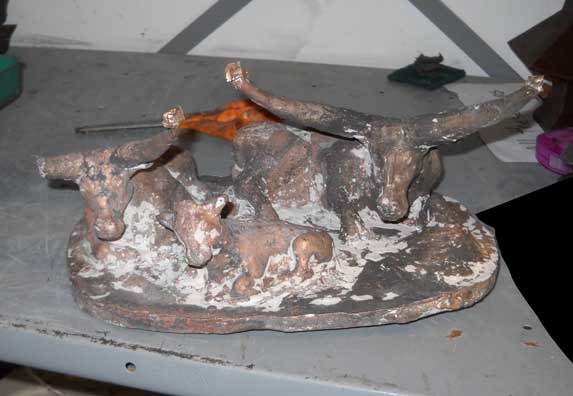Bronze Casting - Shell Removed

After the bronze is poured and cooled (about 24 hours at least), then you break off the shell with a hammer. Then you cut off the vents, sprues, and cup with a cutting wheel. When removing the shell you do have to be a bit careful, but wacking with the hammer did not produce the imperfection noted here.
What happened was that after the sixth dip of the investment process, the figure - now quite heavy with the shell - slipped and bumped against the side of the vat holding the dipping suspension. The horn and part of the vent broke, but fortunately, the wire (put on after the fifth dip) kept the pieces from falling off completely. The broken parts were fitted back in place well as possible and extra wiring put on to hold the piece together. The dipping then continued.
Fortunately the refitting was sufficient to insure that during the pour the molten bronze filled the vents and even into the broken horn. But the horn was weak where the shell had broken and when removing the shell the horn snapped off. However, as shown in the next page, a little TIG welding (done by an expert - not the artist himself) fixed things in place.
It might also be mentioned that at this stage - not just for the welding - it is absolutely imperative that proper safety equipment be worn. When cutting the sprues - using diamond edge wheel on mounted on a hand held angle grinder - not only are gloves worn, but goggles and full face shield are used. In fact when cutting the sprues and vents off this particular cast, everything was going along fine until there was a thwack and a faint jar was felt. Hm. After looking at the statue, no problems were evident; nor when taking off the face shield was anything amiss. It was only before renewing the cutting that it was found that about a quarter of the wheel's edge - about 1/2 inch in depth - had flown off. The noise and "slight jar" was the wheel hitting the face shield, with which a quite serious injury (to say the least) was prevented.